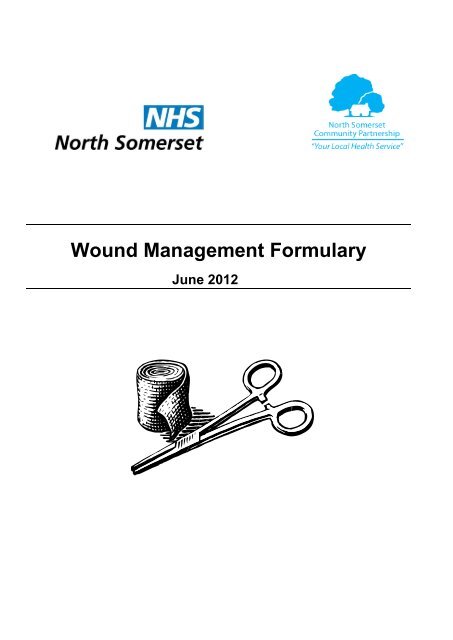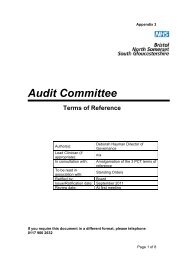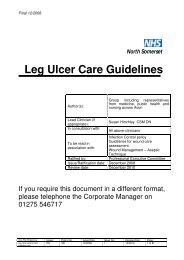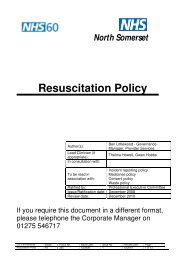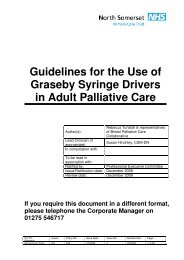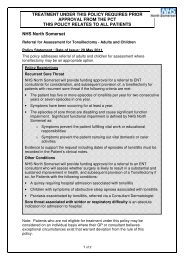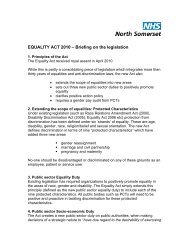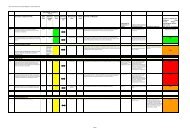WOUND MANAGEMENT FORMULARY - NHS North Somerset
WOUND MANAGEMENT FORMULARY - NHS North Somerset
WOUND MANAGEMENT FORMULARY - NHS North Somerset
You also want an ePaper? Increase the reach of your titles
YUMPU automatically turns print PDFs into web optimized ePapers that Google loves.
Wound Management Formulary<br />
June 2012
Contents<br />
Introduction 3-4<br />
Page<br />
Wound Healing Continuum & Appropriate products 5-11<br />
NSPCT Wound Formulary<br />
Appendix 1 Criteria for using antimicrobial dressings<br />
Appendix 2 Using antimicrobial flow chart<br />
Appendix 3 A-Z Formulary dressings<br />
Appendix 4 Specialist Formulary<br />
Formulary Working Group<br />
12-19<br />
20<br />
21<br />
22<br />
23<br />
24<br />
NSCP and <strong>NHS</strong> NS Wound Management Formulary Version 2. June 2012<br />
2
Introduction<br />
This third edition of the NSPCT Wound Management Formulary is the result of a working<br />
group consisting of the Tissue Viability Nurse and members from Community Nursing,<br />
Community Hospital, Podiatry and G.P. Practices in <strong>North</strong> <strong>Somerset</strong>. The formulary has been<br />
designed to be used by all disciplines involved in managing patients with wounds, except for<br />
nurses working in Nursing Homes. A separate reduced formulary is available for this group<br />
and can be viewed on the NSCP website.<br />
The dressing choices offered are found to be effective for the majority of patients with wounds.<br />
This Formulary should be used in association with the:<br />
Aseptic Technique Policy (2011)<br />
Hand Hygiene Policy (2011)<br />
MRSA for Community Settings Policy (2011)<br />
NSCP Leg Ulcer Assessment Guidelines (2009)<br />
NSCP Pressure Ulcer Policy and Guidelines (2012)<br />
The Bristol, <strong>North</strong> <strong>Somerset</strong>, & South Gloucestershire (BNSSG) Joint Formulary<br />
Aims<br />
Best practice in wound management.<br />
To guide practitioners to select appropriate dressing choice<br />
Standardisation of appropriate products<br />
Cost effectiveness.<br />
Wound Management<br />
Dressings are applied to wounds for many reasons:<br />
To facilitate rapid and cosmetically acceptable healing<br />
To reduce pain<br />
To prevent or combat infection<br />
To contain exudate<br />
To remove or contain odour<br />
To provide maximum comfort for the patient<br />
Wound healing is a dynamic process and the characteristics of a dressing required by the<br />
wounds can change as the wound moves through the different phases of the healing process.<br />
The wound healing continuum, in the first section of this booklet, will aid clinical decisionmaking<br />
regarding appropriate dressings at each stage of wound healing.<br />
Using the formulary<br />
All wounds should be holistically assessed. The underlying pathology that may compromise<br />
wound healing should be identified and addressed where possible.<br />
A diagnosis of wound aetiology is essential as treatment pathways differ according to the<br />
aetiology of the wound. In NSCP additional guidelines are available, with clear treatment<br />
pathways, for leg ulcers and pressure ulcers, as dressings alone will not heal these wounds.<br />
NSCP and <strong>NHS</strong> NS Wound Management Formulary Version 2. June 2012<br />
3
The dressings in the formulary are suitable for the majority of wounds and for each wound<br />
stage there are two product choices to accommodate practitioner and patient preference. The<br />
choice of dressing should be made from the formulary list. A selection of dressings that might<br />
be needed in specific cases is also available on request to the tissue viability service and listed<br />
in appendix 4.<br />
Avoid using layers of dressings as far as possible. Most dressings are designed as wound<br />
contact layers in their own right. Putting them on top of one another only reduces their<br />
effectiveness and is wasteful.<br />
The dressings chosen should promote minimal interference with wounds and frequency of<br />
changes should normally reflect the maximum wear time.<br />
Dressings should be ordered on line using the ordering template. No more than a week’s<br />
supply of dressings should be left in the patient’s home, as the wound requirement will<br />
change, as it moves through the healing process.<br />
Hospital formularies are different to those in primary care and wounds should be reassessed,<br />
in the community, after discharge and care planned as appropriate to the formulary.<br />
New Products and Review of the Formulary<br />
The formulary will be completely updated once every 3 years but some changes to the<br />
dressings available on the template will occur annually. The changes will reflect current best<br />
practice.<br />
New products will be trialled and evaluated by the Tissue Viability Nurse and members of the<br />
Formulary Review Group.<br />
Topical Negative Pressure<br />
Topical Negative Pressure therapy is available for use in <strong>North</strong> <strong>Somerset</strong> Community<br />
Partnership if it facilitates hospital discharge, or prevents admission to hospital. There are<br />
strict criteria to follow for this. All referrals must be made to the Tissue Viability Nurse.<br />
Maggot Therapy<br />
Maggot therapy may be suitable for some wounds and is available on prescription.<br />
Practitioners wishing to use this therapy should have attended an education course prior to<br />
using this therapy. Please contact the Tissue Viability Nurse if you need further advice.<br />
Dressing Samples<br />
Manufacturers’ sales representatives often offer NSCP staff ‘samples’ of dressings. Samples<br />
should not be used to treat <strong>NHS</strong> patients and all offers should be declined<br />
NSCP and <strong>NHS</strong> NS Wound Management Formulary Version 2. June 2012<br />
4
Wound Healing Continuum and Appropriate Products<br />
Description of<br />
Wound<br />
Exudate Management Aims Product Choice<br />
Black Wound<br />
Black tissue is<br />
Necrotic tissue<br />
which is<br />
dehydrated.<br />
No – Low<br />
Exudate<br />
Facilitate removal of necrotic tissue<br />
by rehydrating the wound; this is<br />
essential if the wound is to heal.<br />
Use Purilon Gel with a low adherent<br />
dressing such as Atrauman and<br />
gauze or a film<br />
Actiform Cool is a sheet hydrogel<br />
dressing. The dressing is applied<br />
directly to the wound without the<br />
film backing removed.<br />
Hydrogel :<br />
Purilon Gel<br />
Actiform Cool<br />
Film :<br />
C-View<br />
Hydogel dressings may need<br />
changing daily or alternate days, as<br />
they are not effective if the wound<br />
becomes dry.<br />
Moist wound care is<br />
only appropriate for<br />
wounds with an<br />
adequate blood<br />
supply. Black<br />
wounds with an<br />
inadequate blood<br />
supply e.g. necrotic<br />
digits must be kept<br />
dry.<br />
Please contact the<br />
Tissue Viability<br />
Service if unsure if<br />
a wound is suitable<br />
for debridement.<br />
Hydocolloid dressings will debride<br />
providing minimal exudate is<br />
present. It promotes autolytic<br />
debridement by forming a gel on<br />
contact with exudate.<br />
Honey dressings debride and are<br />
also antibacterial. They are a good<br />
choice on malodorous wounds.<br />
Using foams, on this type of wound<br />
is generally not appropriate. The<br />
foam will reabsorb the gel and<br />
moisture that is required for<br />
autolysis. The wound will also need<br />
frequent dressing changes, which is<br />
not cost effective.<br />
Hydrocolloid :<br />
Tegaderm<br />
Hydrocolloid<br />
Honey Product:<br />
Activon tube<br />
Algivon<br />
Actilite<br />
NSCP and <strong>NHS</strong> NS Wound Management Formulary Version 2. June 2012<br />
5
Description of<br />
Wound<br />
Black – Yellow<br />
Wound<br />
Necrotic tissue and<br />
yellow slough<br />
Exudate Management Aims Product Choice<br />
Low<br />
Exudate<br />
Promote removal of necrotic and<br />
sloughy tissue by autolysis. Provide<br />
moist environment.<br />
A hydrogel is required on black<br />
areas on a low exuding wound.<br />
If the wound is exudating a small<br />
amount, a hydrocolloid may be<br />
beneficial as it will form a gel in<br />
contact with the wound and will aid<br />
autolysis.<br />
Hydrogel :<br />
Purilon Gel<br />
Actiform Cool<br />
Hydrocolloid:<br />
Tegaderm<br />
Hydrocolloid<br />
Mod –<br />
High<br />
Honey dressings debride and are<br />
also antibacterial. Honey is a good<br />
choice on malodorous wounds.<br />
If the wound is wet, the exudate will<br />
need to be managed by using a<br />
more absorbent dressing.<br />
The formulary choices are, an<br />
alginate or a cellulose fibre gelling<br />
dressing.<br />
A hydrofibre ribbon should be used<br />
on wounds that require packing as<br />
the product has a knitted thread<br />
inserted to ensure no fibres are<br />
shed from the dressing.<br />
As these products absorb the<br />
exudate they gel, which aids<br />
autolysis.<br />
Foams should only be used if they<br />
manage exudate sufficiently to<br />
significantly decrease dressing<br />
changes.<br />
Careful consideration should be<br />
given to the choice of secondary<br />
dressing. If the wound needs<br />
daily or frequent changes, an<br />
absorbent dressing pad should<br />
be used.<br />
Honey product<br />
Activon tube<br />
Algivon<br />
Actilite<br />
Cellulose fibre<br />
gelling dressing:<br />
Durafiber<br />
Alginate:<br />
Sorbsan plus<br />
Hydofibre<br />
Aquacel Ribbon<br />
Foam :<br />
Biatain<br />
Allevyn<br />
Adhesive<br />
Tegaderm<br />
Foam<br />
Secondary Dressing:<br />
Dressing Pad<br />
Kerramax<br />
NSCP and <strong>NHS</strong> NS Wound Management Formulary Version 2. June 2012<br />
6
Description of<br />
Wound<br />
Yellow Wound<br />
Slough is usually<br />
yellow or white<br />
Exclude possibility<br />
of pus and<br />
spreading infection<br />
Exudate Management Aims Product Choice<br />
Low<br />
Exudate<br />
Mod –<br />
High<br />
Facilitate removal of sloughy tissue<br />
to promote healing. Provide a moist<br />
environment for autolysis to occur.<br />
Depending on the level of exudate<br />
either a gel or a hydrocolloid may<br />
be appropriate.<br />
If using a gel cover with a low<br />
adherent dressing and gauze.<br />
Honey dressings will debride and<br />
are antibacterial. They are a good<br />
choice on malodorous wounds<br />
Actilite is a honey coated low<br />
adherent dressing and suitable on<br />
superficial wounds and under<br />
compression<br />
If the wound is wet, the exudate will<br />
need to be managed using an<br />
alginate, hydrofibre or cellulose fibre<br />
gelling dressing. As these products<br />
absorb exudate they gel, which aids<br />
autolysis.<br />
Hydrogel:<br />
Purilon Gel<br />
Actiform cool<br />
Hydrocolloid:<br />
Tegaderm<br />
Hydrocolloid<br />
Honey product<br />
Activon Tube<br />
Algivon<br />
Actilite<br />
Cellulose fibre<br />
gelling dressing:<br />
Durafiber<br />
Alginate:<br />
Sorbsan Plus<br />
Cavity wounds should be packed<br />
lightly with a hydrofibre ribbon which<br />
is chosen because it does not shed<br />
fibres.<br />
Foams should only be used if they<br />
manage exudate sufficiently to<br />
significantly decrease dressing<br />
changes. Silicone coated foams can<br />
be used if the skin surrounding the<br />
wound is delicate and there are<br />
concerns about damage on removal<br />
of dressing.<br />
Careful consideration should be<br />
given to the choice of secondary<br />
dressing. If the wound needs<br />
daily or frequent changes, an<br />
absorbent dressing pad should<br />
be used.<br />
Hydofibre<br />
Aquacel Ribbon<br />
Foam:<br />
Biatain<br />
Allevyn<br />
Adhesive<br />
Tegaderm<br />
Foam<br />
Silicone Coated<br />
Foam:<br />
Siltec<br />
Allevyn Gentle<br />
Border<br />
Secondary Dressing:<br />
Dressing Pad<br />
Kerramax<br />
NSCP and <strong>NHS</strong> NS Wound Management Formulary Version 2. June 2012<br />
7
Description of<br />
Wound<br />
Yellow – Red<br />
Wound<br />
Slough and<br />
granulation tissue<br />
present<br />
Exudate Management Aims Product Choice<br />
Low<br />
Exudate<br />
Mod –<br />
High<br />
Promote moist environment to<br />
enhance healing and slough<br />
removal.<br />
Depending on the level of exudate<br />
either a gel or a hydrocolloid may<br />
be appropriate.<br />
If using a gel cover with a low<br />
adherent dressing and gauze<br />
Light silicone coated foams should<br />
be considered, for patient comfort if<br />
the surrounding skin is fragile or to<br />
increase wear time of the dressing<br />
Actilite is a honey coated low<br />
adherent dressing and suitable on<br />
superficial wounds and under<br />
compression<br />
Manage exudate to enhance<br />
healing by using an alginate or<br />
cellulose fibre gelling dressing.<br />
These products gel as they absorb<br />
the exudate which aids autolysis.<br />
Cavity wounds should be packed<br />
lightly with a hydrofibre ribbon which<br />
is chosen because it does not shed<br />
fibres.<br />
Careful consideration should be<br />
given to the choice of secondary<br />
dressing. If the wound needs<br />
daily or frequent changes, an<br />
absorbent dressing pad should<br />
be used.<br />
Foams should only be used if they<br />
manage exudate sufficiently to<br />
significantly decrease dressing<br />
changes<br />
Hydrogel:<br />
Purilon Gel<br />
Actiform Cool<br />
Hydrocolloid:<br />
Tegaderm<br />
Hydrocolloid<br />
Silicone Coated<br />
Foam<br />
Siltec Lite<br />
Allevyn Gentle<br />
Border Lite<br />
Honey product:<br />
Actilite<br />
Cellulose fibre<br />
gelling dressing:<br />
Durafiber<br />
Alginate:<br />
Sorbsan Plus<br />
Hydofibre:<br />
Aquacel Ribbon<br />
Foam:<br />
Biatain<br />
Allevyn<br />
Adhesive<br />
Tegaderm<br />
Foam<br />
Silicone Coated<br />
Foam<br />
Cutimed Siltec<br />
Allevyn Gentle<br />
Border<br />
SecondaryDressing:<br />
Dressing Pad<br />
Kerramax<br />
NSCP and <strong>NHS</strong> NS Wound Management Formulary Version 2. June 2012<br />
8
Description of<br />
Wound<br />
Exudate Management Aims<br />
Product Choices<br />
Red<br />
Granulating<br />
Wound<br />
Low<br />
Moist environment to promote<br />
active healing.<br />
Leave undisturbed for as long as<br />
exudate management allows.<br />
If problems with dressing adhering<br />
to the wound bed, first consider<br />
light silicone coated foam<br />
dressings<br />
Hydrocolloid:<br />
Tegaderm<br />
Hydrocolloid<br />
Low adherent<br />
Dressing<br />
Atrauman<br />
Adaptic Touch<br />
Telfa<br />
Beware of dark red<br />
tissue that bleeds<br />
easily, this can<br />
indicate high<br />
bacterial burden or<br />
infection if<br />
accompanied by<br />
other signs.<br />
Pink<br />
Epithelialising<br />
Wound<br />
Mod –<br />
High<br />
Telfa has been chosen for podiatry<br />
patients but can be considered for<br />
sutured wounds and a wound that<br />
is superficial with minimal exudate.<br />
Maintain moist environment and<br />
manage exudate.<br />
Manage exudate to enhance<br />
healing by using an alginate or<br />
cellulose fibre gelling dressing.<br />
These products gel as they absorb<br />
the exudate this aids autolysis<br />
Cavity wounds should be packed<br />
lightly with a hydrofibre ribbon<br />
which is chosen because it does<br />
not shed fibres.<br />
Silicone Coated<br />
Foam<br />
Siltec Lite<br />
Allevyn Gentle<br />
Border Lite<br />
Cellulose fibre<br />
gelling dressing:<br />
Durafiber<br />
Hydofibre<br />
Aquacel<br />
Ribbon<br />
Foam:<br />
Biatain<br />
Allevyn<br />
Adhesive<br />
Tegaderm<br />
Foam<br />
The aim of treatment at this stage<br />
of healing is to promote minimum<br />
disturbance of the wound and<br />
foams and silicone coated foams<br />
are usually the most appropriate at<br />
this stage of healing<br />
Silicone Coated<br />
Foam<br />
Siltec/Siltec<br />
Lite<br />
Allevyn Gentle<br />
Border<br />
Secondary<br />
Dressing:<br />
Dressing Pad<br />
Kerramax<br />
NSCP and <strong>NHS</strong> NS Wound Management Formulary Version 2. June 2012<br />
9
Signs of critical<br />
colonisation<br />
Exudate Management Aims & Use of<br />
Antimicrobial Products<br />
Product Choice<br />
Wound bed<br />
deterioration :<br />
High bacterial burden<br />
Increase in slough<br />
Increase in necrosis<br />
Dark granulation<br />
tissue<br />
Increase in malodour<br />
Increase in pain<br />
Increase in wound<br />
size<br />
Wound healing static<br />
Surrounding erythema<br />
Antimicrobial products are<br />
suitable for use of infected and<br />
wounds that are critically<br />
colonised with bacteria.<br />
They are indicated for shortterm<br />
use. If the wound has not<br />
responded to antimicrobials<br />
within 2 weeks it will not be<br />
effective and should be<br />
discontinued.<br />
Patient with wound infection<br />
should also be treated with<br />
antibiotic therapy.(Refer to the<br />
BNSSG formulary)<br />
Wound infection<br />
Increase in slough.<br />
Increase in necrosis.<br />
Increase in malodour.<br />
Increase in wound<br />
size.<br />
Increase in exudate<br />
that is often purulent<br />
or bloody.<br />
Spreading erythema<br />
Bleeding granulation<br />
tissue.<br />
Pockets of pus at<br />
base of wound.<br />
Wound painful.<br />
Patient feels unwell.<br />
Low<br />
Med/high<br />
Urgotull SSD is a non-adherent<br />
dressing impregnated with silver<br />
sulphadiazine. It does not require<br />
moisture to activate and is suitable<br />
for wounds needing silver<br />
dressings with low exudates.<br />
Silvercel is an absorbent<br />
antimicrobial dressing with a nonadherent<br />
layer designed to<br />
protect the wound bed particularly<br />
at dressing changes<br />
Iodoflex and Iodosorb contain<br />
iodine within a cadexomer matrix.<br />
The design of the dressing<br />
enables it to absorb large amounts<br />
of exudate. It is the most effective<br />
antimicrobial to deslough wounds.<br />
It is applied directly to the wound<br />
and changed when the colour<br />
changes.<br />
Urgotul SSD<br />
Silvercel<br />
Iodoflex<br />
Iodosorb<br />
NSCP and <strong>NHS</strong> NS Wound Management Formulary Version 2. June 2012<br />
10
Indolent Wounds with<br />
Delayed Healing. Exudate Management Aims Product<br />
Choice<br />
Wounds, which do not<br />
progress through the normal<br />
stages of healing, should be<br />
reassessed and any<br />
causative factors identified<br />
and treated where possible.<br />
Wounds that fail to<br />
progress through the normal<br />
stages of healing are<br />
pathophysiologically<br />
characterised by chronic<br />
inflammation and an<br />
abnormal balance between<br />
Matrix Metalloproteinases<br />
(MMP) and growth factors.<br />
Low<br />
Mod<br />
Suitable for chronic non-infected<br />
wounds on patients who are at<br />
risk of delayed healing.<br />
Corrects the biochemical<br />
balance between MMPs and<br />
growth factors to kick start the<br />
healing process. Results often<br />
not seen for 4 weeks<br />
Wounds that show no<br />
progress after six weeks<br />
using these dressings should<br />
be referred to the Tissue<br />
Viability Nurse for<br />
reassessment.<br />
Proteinase<br />
inhibiting<br />
dressing :<br />
Urgo<br />
START<br />
Contact<br />
Urgo<br />
START<br />
Please seek tissue viability<br />
support if dealing with an<br />
indolent wound with high<br />
exudate levels.<br />
Cutimed Sorbact is<br />
indicated for use on wounds<br />
that are stuck due to<br />
repeated critical<br />
colonisation. It can also be<br />
used first line on wet<br />
infected wounds<br />
Mod/high<br />
This dressing is coated with a<br />
natural fatty acid, which binds<br />
microbes to it. It is suitable for<br />
long-term use on wounds that<br />
do not progress due to frequent<br />
periods of critical colonisation. It<br />
is only suitable for wounds with<br />
moderate exudates levels.<br />
Cutimed<br />
Sorbact<br />
NSCP and <strong>NHS</strong> NS Wound Management Formulary Version 2. June 2012<br />
11
NSCP <strong>WOUND</strong> <strong>MANAGEMENT</strong> <strong>FORMULARY</strong><br />
Dressing Type Indications and Tips Product Choice<br />
Film Dressings<br />
Vapour permeable films allow the<br />
passage of water vapour and<br />
oxygen but not water or microorganisms.<br />
Only suitable for superficial wounds<br />
with very low or no exudate. Not<br />
suitable for patients with thin friable<br />
skin as may cause damage on<br />
removal.<br />
C-view<br />
11x12cm<br />
15cm x 20cm<br />
Non/Low Adherent Wound<br />
Contact Dressings<br />
Atrauman is a non-medicated,<br />
polyester mesh dressing<br />
impregnated with neutral<br />
triglycerides.<br />
Used as a contact layer on larger<br />
wounds. Low Adherent<br />
Atrauman and N-A Ultra are<br />
dressings of choice under<br />
compression therapy.<br />
Profore Wound<br />
Contact Layer<br />
14 x 20cm<br />
N-A Ultra<br />
9.5 x 9.5cm<br />
Atrauman<br />
7.5 x10cm<br />
10 x 20cm<br />
20 x 30cm<br />
Telfa consists of a thin layer of<br />
absorbent cotton fibres, enclosed<br />
in a perforated sleeve<br />
Telfa is only suitable for podiatry<br />
use and as a secondary dressing<br />
over sutures or in wounds with<br />
minimal exudate.<br />
Telfa<br />
10cm x 5cm<br />
10cm x 12.5cm<br />
Adaptic Touch is a non-adherent<br />
silicone dressing<br />
Adaptic Touch can be left in situ up<br />
to 14 days. It can also be used to<br />
line a wound bed during topical<br />
negative pressure therapy<br />
Adaptic Touch<br />
5 x 7.6cm<br />
7.6 x11cm<br />
12.7 x15cm<br />
Acilite is a low-adherent viscose<br />
net dressing coated with 99%<br />
Manuka honey and 1% Manuka<br />
oil<br />
Actilite is a broad spectrum<br />
antimicrobial dressing for use on<br />
low exuding wounds.<br />
Actilite<br />
10x10cm<br />
NSCP and <strong>NHS</strong> NS Wound Management Formulary Version 2. June 2012<br />
12
Dressing Type Indications and Tips Product Choice<br />
Perforated film absorbent<br />
Dressings<br />
For superficial wounds with low<br />
exudate such as surgical wounds.<br />
Opsite Post Op<br />
9.5 x 8.5cm<br />
8.5 x15.5cm<br />
12 x 10cm<br />
10 x 25cm<br />
Perforated absorbent<br />
Dressings<br />
For superficial wounds with low<br />
exudate such as surgical wounds.<br />
Mepore<br />
6 x7cm<br />
9 x10cm<br />
9 x 20cm<br />
9 x 25cm<br />
Super Absorbent dressing<br />
Odour Absorbing<br />
Dressings<br />
These dressings absorb the<br />
molecules released by the wound<br />
which may be responsible for<br />
wound odour<br />
If exudate is a considerable<br />
problem requiring frequent dressing<br />
changes the secondary dressing<br />
should be a super absorbent<br />
dressing<br />
Useful in managing malodorous<br />
wounds such as leg ulcers or<br />
fungating wounds.<br />
Not a primary dressing and so<br />
must not come into contact with<br />
the wound.<br />
Kerramax<br />
10 x10cm<br />
10 x 22cm<br />
20 x 22cm<br />
Clinisorb<br />
10 x10cm<br />
10 x 20cm<br />
Paste Bandages<br />
Use to reduce inflammation and to<br />
treat varicose eczema in the lower<br />
limb.<br />
Can sometimes cause allergic<br />
reactions<br />
Ichthopaste<br />
7.5cm x 6m<br />
Zinc oxide<br />
impregnated<br />
medicated stocking<br />
17x 13 x 1cm<br />
Proteases inhibiting<br />
dressing<br />
Use in non-infected wounds in<br />
which are showing signs of delayed<br />
healing.<br />
Contain particles, which on contact<br />
with wound exudates are released<br />
The particles bind to the excess<br />
proteases thus promoting the<br />
activity of growth factors. This will<br />
kick start chronic indolent wounds.<br />
Urgo START<br />
contact<br />
5 x7cm<br />
11 x11cm<br />
Urgo START<br />
6 x 6cm<br />
10 x10cm<br />
NSCP and <strong>NHS</strong> NS Wound Management Formulary Version 2. June 2012<br />
13
Dressing Type Indications and Tips Product Choice<br />
Alginates<br />
Calcium Alginate derived from<br />
seaweed, which becomes a<br />
hydrophilic gel when in contact<br />
with wound secretions, providing<br />
a moist environment.<br />
Cellulose Fibre Gelling<br />
Dressing<br />
Durafiber is a highly absorbent,<br />
non woven gelling fibre filler<br />
dressing, which forms a soft<br />
cohesive gel sheet when it comes<br />
into contact with exudate<br />
Hydrofibre Dressing<br />
Aquacel ribbon is the choice for<br />
wounds that require packing.<br />
Hydrofibre dressings are highly<br />
absorbent and form a gel when in<br />
contact with the wound bed. The<br />
ribbon has a knitted thread<br />
running through the product. This<br />
minimises the risk of the dressing<br />
shedding particles into the wound<br />
Highly absorbent, appropriate for<br />
medium to heavily exuding wounds.<br />
Can be left on wound for 3 – 7<br />
days.<br />
Not suitable for dry or low exuding<br />
wounds.<br />
Alginates have a haemostatic<br />
component and are useful to stem<br />
bleeding in a wound.<br />
Not suitable for dry or low exuding<br />
wounds<br />
Both dressings can remain in place<br />
from 3-7 days<br />
Use the gelling fibre dressing<br />
Durafibre for wounds that do not<br />
require packing<br />
Use The hydrofibre dressing<br />
Aquacel for wounds that require<br />
packing<br />
Sorbsan Plus<br />
7.5 x10cm<br />
10 x15cm<br />
10 x 20cm<br />
Sorbsan Plus S A<br />
11.5 x14cm<br />
14 x19cm<br />
Durafiber<br />
5 x 5cm<br />
10 x10cm<br />
15 x15cm<br />
Aquacel Ribbon<br />
2g x 45cm ribbon<br />
1gx 45cm ribbon<br />
Honey Dressings<br />
Honey has antibacterial,<br />
desloughing and deodorising<br />
properties<br />
Activon<br />
25g<br />
Algivon<br />
5 x5cm<br />
10 x10cm<br />
Actilite<br />
10 x10cm<br />
NSCP and <strong>NHS</strong> NS Wound Management Formulary Version 2. June 2012<br />
14
Dressing Type Indications and Tips Product Choice<br />
Hydrocolloids<br />
Interactive when in contact with<br />
wound exudate. Absorbs fluid and<br />
becomes a gel.<br />
Suitable for desloughing wounds<br />
and promoting granulation so can<br />
be used at any stage of wound<br />
healing.<br />
For light to moderate exuding<br />
wounds.<br />
Caution should be taken when<br />
using occlusive dressings on<br />
diabetic patients as they can<br />
increase the risk of anaerobic<br />
infection.<br />
May cause hyper-granulation.<br />
Tegaderm<br />
Hydrocolloid<br />
10 x12cm<br />
13 x15cm<br />
Comfeel Plus<br />
Transparent<br />
5 x7cm<br />
10 x10cm<br />
Hydrogels<br />
Gels can rehydrate wounds and<br />
provide a moist environment<br />
Barrier Film<br />
Rehydrates necrotic and sloughy<br />
wounds to promote debridement.<br />
Can be used at any stage of<br />
healing from debridement to<br />
granulation. Not recommended for<br />
heavily exuding wounds. Requires<br />
a secondary dressing.<br />
Change dressing every 1 – 3 days.<br />
To protect vulnerable skin from<br />
exudate and moisture<br />
Actiform Cool<br />
5 x 6.5cm<br />
10 x10cm<br />
Purilon Gel<br />
8g<br />
No sting skin prep<br />
(name soon to be<br />
changed to Secura)<br />
1ml wipe = 41p<br />
NSCP and <strong>NHS</strong> NS Wound Management Formulary Version 2. June 2012<br />
15
Dressing Type<br />
Foam Dressings<br />
Absorbent polyurethane<br />
foam.<br />
Indications and<br />
Tips<br />
Foams absorb excess exudate from the<br />
wound surface whilst maintaining a moist<br />
healing environment.<br />
Available as flat sheets with or without an<br />
adhesive border.<br />
The rationale for using foams is extending<br />
wear time and comfort for the patient.<br />
Frequent removal of the adhesive dressings<br />
will cause damage to the surrounding skin.<br />
If frequent dressing changes are required<br />
consider using an absorbent dressing pad<br />
instead.<br />
Product Choice<br />
Biatain<br />
5 x7cm<br />
10 x10cm<br />
15 x15cm<br />
20 x 20cm<br />
Allevyn Adhesive<br />
7.5 x 7.5cm<br />
10 x 10cm<br />
12.5 x 12.5cm<br />
17.5 x 17.5cm<br />
Soft Silicone<br />
Dressing<br />
Silicone and Silicone<br />
coated dressings are non<br />
adherent and are<br />
removed without trauma<br />
Cutimed Siltec is a foam dressing that has<br />
a silicone wound contact layer. This<br />
ensures that the dressing is removed with<br />
minimal trauma.<br />
Allevyn Gentle Border minimises pain and<br />
trauma to the wound at dressing change<br />
due to a silicone gel adhesive.<br />
Both these dressings should be chosen for<br />
patients with fragile skin<br />
Allevyn Adhesive<br />
(sacral)<br />
22 x 25 cm<br />
Tegaderm Foam<br />
10 x 11cm<br />
14 x 14cm<br />
Cutimed Siltec<br />
7.5 x 7.5cm<br />
10 x 10 cm<br />
Cutimed Siltec Lite<br />
5 x 6cm<br />
10 x10cm<br />
Allevyn Gentle Border<br />
7.5 x 7.5cm<br />
10 x 10cm<br />
12.5 x 12.5cm<br />
17.5 x 17.5cm<br />
Sacrum<br />
16.8 x 17.1cm<br />
Allevyn<br />
Gentle Border Lite<br />
5 x 5cm<br />
7.5 x 7.5cm<br />
10 x 10cm<br />
7.7 x 8.6cm (oval)<br />
5.5cm x 12cm<br />
NSCP and <strong>NHS</strong> NS Wound Management Formulary Version 2. June 2012<br />
16
Dressing Type<br />
Indication and Tips<br />
Product Choice<br />
Gauze and Dressing<br />
Pads<br />
Used for exudate management. An<br />
effective primary dressing should first be<br />
chosen to provide an optimal environment<br />
for the wound to heal.<br />
Sterile Gauze<br />
10 x10cm x 25 squares<br />
Lower limbs that are exudating may benefit<br />
from compression or supportive bandages<br />
where appropriate. Seek advice if unsure<br />
about the suitability.<br />
Non sterile<br />
Dressing Pads<br />
10 x 12cm<br />
20 x 20cm<br />
20 x 40cm<br />
Sterile Dressing Pads<br />
20 x 20cm<br />
20 x 40cm<br />
K-Soft<br />
10cm x 3.5cm<br />
K-Soft Long<br />
10cm x 4.5m<br />
Tape Securing dressings and bandages Clinipore<br />
1.25cm x10m<br />
2.5cm x 10m<br />
Mefix<br />
5cm x 5m<br />
10cm x 5m<br />
Stockinette Securing dressings and bandages Comfifast<br />
Red line 3.5cm x1m<br />
Green line 5.0cm x1m<br />
Blue line 7.5cm x 5m<br />
Yellow Line 10.25cm x<br />
5m<br />
NSCP and <strong>NHS</strong> NS Wound Management Formulary Version 2. June 2012<br />
17
Dressing Type Indications and Tips Product Choice<br />
Antimicrobial<br />
Dressings<br />
High bacterial burden<br />
(critical colonisation) in a<br />
wound is a barrier to<br />
healing.<br />
Antimicrobial dressings<br />
should be used when<br />
there are clinical signs of<br />
critical colonisation<br />
present which are<br />
preventing the wound<br />
from healing.<br />
NB. Patients with diabetes<br />
do not always have<br />
obvious signs of wound<br />
infection and extra care<br />
should be taken with this<br />
group.<br />
Antimicrobials may reduce the bacterial<br />
burden and prevent further development<br />
of infection. Where cellulitis is present a<br />
swab should be taken and systemic<br />
antibiotics commenced.<br />
Cadexomer Iodine, Silver and Honey are<br />
effective against MRSA<br />
Iodoflex, and Silvercel are not suitable for<br />
dry or wounds with little exudate.<br />
NB: Iodine dressings should be used with<br />
caution with patients who have thyroid or<br />
renal disease. They should not be used on<br />
patients who are receiving Lithium or<br />
pregnant woman. The amount and time used<br />
must adhere to the manufacturers’<br />
guidelines.<br />
Cutimed Sorbact binds bacteria to it and<br />
should be considered as an alternative to<br />
silver on patients who require frequent<br />
treatments with silver dressings. It is suitable<br />
for long-term use.<br />
If considering using an antimicriobial<br />
dressing, please see additional<br />
information in appendix one and two<br />
Inadine<br />
5cm x 5cm<br />
9.5 x 9.5cm<br />
Urgotul SSD<br />
10 x12cm<br />
15cm x 20cm<br />
Iodoflex<br />
5g,10g<br />
Iodosorb<br />
10g tube<br />
Silvercel<br />
5 x 5cm<br />
11 x11cm<br />
10 x 20cm<br />
Rope<br />
2.5 x 30cm<br />
Cutimed Sorbact<br />
Swab<br />
4 x 6cm<br />
7 x 9cm<br />
Ribbon<br />
2 x 50cm<br />
Pad<br />
7 x 9cm<br />
10 x10cm<br />
NSCP and <strong>NHS</strong> NS Wound Management Formulary Version 2. June 2012<br />
18
Dressing Type Indications and Tips Product Choice<br />
Compression<br />
Bandages<br />
Retention Bandage<br />
For use in the management of venous<br />
ulceration.<br />
Use in accordance with the Leg Ulcer<br />
Management Guidelines<br />
K Four<br />
K-Soft 10cm x 3.5m<br />
K-Lite 10cm x 4.5m<br />
K-Plus 10cm 8.7m<br />
Ko-Flex10cm x 6m<br />
K-Lite Long<br />
10cm x 5.25m<br />
K-Plus long<br />
10cm x 10.25m<br />
K-ThreeC<br />
10cm x 3m<br />
Coban 2 multilayer<br />
Bandage kit<br />
1 Kit<br />
Coban 2 Lite<br />
I Kit<br />
Actico Cohesive<br />
10cm x10m<br />
K-Band<br />
5cm x 4m<br />
10cm x 4m<br />
Irrigation Fluids<br />
Most wounds do not require cleaning; it is<br />
more beneficial to leave the wound bed<br />
undisturbed unless there is debris present.<br />
Normasol<br />
25 sachets<br />
Sterile Dressing<br />
Packs<br />
Softdrape<br />
Small glove<br />
Medium glove<br />
Large glove<br />
Skin Closures<br />
Steristrips<br />
6 x 75mm x 3 strips<br />
NSCP and <strong>NHS</strong> NS Wound Management Formulary Version 2. June 2012<br />
19
Appendix One<br />
Criteria for Starting Antimicrobial Dressings<br />
Antimicrobial dressings should only be considered for use on wounds that are<br />
infected or wounds that are critically colonised with bacteria.<br />
Wound infection should also be treated with 10 -14 days of antibiotic therapy.<br />
Signs and symptoms of high bacterial burden.<br />
Wound bed deterioration, increase in slough, necrosis<br />
Wound exudate increased and change in colour<br />
Wound has become malodorous<br />
Increase in pain / discomfort<br />
Discolouration of granulation tissue ( usually becomes darker)<br />
Friable bleeding granulation tissue<br />
Static Healing<br />
Erythema (redness) surrounding wound<br />
Additional Signs and symptoms of wound infection<br />
Friable bleeding granulation tissue<br />
Bridging of the epithelium<br />
Pockets of pus at the base of the wound<br />
Pyrexia patient often unwell<br />
Other reasons for deterioration must also be explored that may be associated with the<br />
patients’ general health and the control of any underlying disease processes.<br />
Diabetic control<br />
Adequate nutrition<br />
Anaemia.<br />
Consider the underlying cause of the wound and ensure this has been addressed as far as<br />
possible e.g.<br />
Pressure removed if a pressure ulcer<br />
Reversal of venous hypertension by compression therapy.<br />
The wound must be traced or measured and described before commencing an antimicrobial<br />
so that an accurate evaluation of the progress can be made<br />
Antimicrobial therapy should only be used whilst the symptoms are present to address the<br />
bacterial load and then discontinued.<br />
NSCP and <strong>NHS</strong> NS Wound Management Formulary Version 2. June 2012<br />
20
If the wound does not respond within 2 weeks of antimicrobial therapy it is not going to<br />
be effective. It should be discontinued and advice sought from the Tissue Viability<br />
Service.<br />
NSCP and <strong>NHS</strong> NS Wound Management Formulary Version 2. June 2012<br />
21
Appendix Two<br />
Using Antimicrobials in Wound Care<br />
Signs of critical colonisation<br />
Delayed healing (compared with<br />
normal rate for site/condition)<br />
Wound bed deterioration increase in<br />
slough or necrosis<br />
Wound has become malodorous<br />
Increase in pain/discomfort<br />
Increase in exudate and change of<br />
colour/consistency<br />
Wound static or deteriorating<br />
The patient is not generally unwell<br />
Use first line antimicrobial for<br />
two weeks.<br />
Silvercell or Iodofex/iodosorb<br />
(mod-high exudate) Urgotul<br />
SSD (low exudates)<br />
Signs of wound infection<br />
Wound bed deterioration increase in slough<br />
and/or necrosis<br />
Increased pain.<br />
Wound has become malodorous.<br />
Increase in exudates, which can be purulent<br />
or contain blood.<br />
Friable bleeding granulation tissue.<br />
Bridging of the epithelium<br />
Pockets of pus at the base of the wound<br />
Spreading erythema<br />
Patient usually feels unwell<br />
Swab wound<br />
Commence antibiotic therapy for<br />
at least 10 days duration.<br />
Use first line antimicrobial for two<br />
weeks.<br />
Silvercell or Iodofex/iodosorb<br />
(mod-high exudates) Urgotul SSD<br />
(low exudates)<br />
Evaluate outcome of treatment<br />
Signs and symptoms<br />
resolved.<br />
Stop Antimicrobials<br />
Signs and symptoms<br />
reduced<br />
Continue for two more<br />
weeks and then stop<br />
Signs and symptoms<br />
unchanged.<br />
Stop<br />
antimicrobials<br />
Reassess patient<br />
Seek advice from<br />
specialist nurse if<br />
required<br />
Wounds that respond to silver but deteriorate once silver is stopped<br />
should be treated with Cutimed Sorbact providing exudate is moderate.<br />
Please seek tissue viability support for MRSA infected wounds with low<br />
exudate.
Appendix 3<br />
Alphabetical list of dressings in NSPCT Formulary<br />
Actico cohesive (10cmx10cm)<br />
Actiform Cool (5x6.5cm, 10x10cm)<br />
Actilite (10x10cm)<br />
Activon tube honey. (25g)<br />
Adaptic Touch (5 x7.6cm,7.6 x11cm, 12.7x15cm)<br />
Algivon Manuca honey (5x5cm,<br />
10x10cm)<br />
Allevyn (5x5cm, 10x10cm, 20x20cm)<br />
Allevyn Adhesive (7.5cmx7.5cm,<br />
10x10cm, 12.5x12.5cm 17.5<br />
x17.5cm, 22 x 25cm)<br />
Allevyn Gentle Border (7.5cmx7.5cm,<br />
10cmx10cm,<br />
12.5x12.5cm)(17.5 x17.5cm)<br />
Allevyn Gentle Border Lite (5 x 5cm,7.5 x7.5cm<br />
10x10cm,7.7x8.6cm,<br />
5.5cm x 12cm)<br />
Aquacel Ribbon (2x45g,1cmx45cm)<br />
Atrauman (7x5cmx10cm, 10cmx20cm<br />
20x30cm)<br />
Biatain (5x7cm, 10x10cm, 15x15cm, 20x20cm)<br />
Clinipore tape (1.25cmx5m, 2.5cmx5m)<br />
CliniSorb (10x10cm, 10x20cm)<br />
Coban 2 Multilayer Bandage kit<br />
Coban 2 Lite Multilayer Bandage kit<br />
Comfeel Plus Transparent (5cmx7cm,<br />
10x10cm)<br />
Comfifast ( Red Line, Green Line, Blue Line,<br />
Yellow Line)<br />
Cutimed Siltec (7.5x7.5cm, 10x10cm,)<br />
Cutimed Siltec lite (5x6cm, 10x10cm)<br />
Cutimed Sorbact (swab 4x6cm, 7x9cm)<br />
(ribbon 2x50cm)<br />
(pad 7x5cm, 10x10cm)<br />
C View (11x12cm, 15 x20cm )<br />
Dressing Pads Non sterile (10cm x 12cm,<br />
20x20cm, 20x40cm)<br />
Dressing Pads Sterile (20x 20cm 20x40cm)<br />
Durafiber (5x5cm, 10x10cm, 15x15cm)<br />
Ichthopaste (7.5cmx6m)<br />
Inadine (5x5cm, 9.5x9.5cm)<br />
Iodoflex paste (5g,10g)<br />
Iodosorb (5g tube)<br />
K-Band (5cmx4m, 10cmx4m)<br />
K-Four<br />
1. K-Soft (10cm x 3.5 cm,10cm x<br />
4.5cm)<br />
2. K-Lite (10cmx4.5m)<br />
3. K-Plus (10cmx 8.7m)<br />
4. Ko-flex (10cmx6m)<br />
K-four for ankles above 25cm<br />
Components K-lite (10cm x 5.25cm)<br />
K-plus (10cm x 10.25cm)<br />
Ko-flex (10cm x 7m)<br />
K-ThreeC (10cm x 3m)<br />
Kerramax (10x10cm, 10x22cm,<br />
20x22cm)<br />
Mefix (5cm x5m, 10cmx5m)<br />
Mepore (6x7cm, 9x10cm, 9x20cm,<br />
9x25cm)<br />
N-A Ultra (9.5mx9.5cm)<br />
No Sting Skin Prep (1ml wipes)<br />
Non-woven fabric swabs.<br />
(sterile 10x10cm)<br />
Normasol Sachets<br />
Op-site Post Op (9.5x8.5cm<br />
8.5x15.5cm, 12x10cm, 10 x 25cm)<br />
Profore Wound Contact Layer<br />
Purilon Gel (8g)<br />
Silvercel (5x5cm, 11x11cm, 10x20cm,<br />
2.5x30cm)<br />
Softdrape dressing packs (small,<br />
medium, large)<br />
Sorbsan plus (7.5x10cm, 10x15cm<br />
10x20cm)<br />
Sorbsan plus SA (11.4x14cm, 14x19cm,<br />
14x24cm)<br />
Steristrips (6 x 75mm)<br />
Tegaderm Foam (10x11cm,<br />
14x15cm)<br />
Tegaderm hydrocolloid (10x12cm,<br />
14x15cm)<br />
Telfa (10x5cm, 10x12.5cm)<br />
Urgo Start (6x6cm, 10x10cm)<br />
Urgo Start Contact (5x7cm, 11x11cm)<br />
Urgotul SSD (11x11cm, 16x2cm)<br />
Zinc oxide impregnated stocking<br />
NSCP and <strong>NHS</strong> NS Wound Management Formulary Version 2. June 2012<br />
23
Appendix 4<br />
Specialist Formulary<br />
This template has been posted on every joint nhs.net account and can be used to access a<br />
dressing that might be required for specific named patients. It is expected that formulary<br />
products will be used in the first instance and all requests must demonstrate a sound rationale<br />
for requesting the product.<br />
Alleyyn Heel dressing 10.5 x 13.5cm 5 per box<br />
Acticoat Flex 3 10x10cm 12 per box<br />
10x20cm 12 per box<br />
Mepilex 15cm x16cm 5 per box<br />
20cm x21 cm<br />
Octenaline Wound 300mls 1<br />
Cleaner<br />
Flaminal Forte 50g Tube<br />
Debrisoft 10x10cm 5 pads<br />
Urgo Clean 6x 6cm 10 per box<br />
10x10cm 10 per box<br />
Sorbion S Sachet 7.5 x7.5cm 10 per box<br />
10x10cm<br />
15x15cm<br />
20x20cm<br />
Sorbion Sana 8.5 x8.5cm 10 per box<br />
Biatain IBU 10x12cm 5 per box<br />
15x15cm<br />
Prosheild Plus 115g each<br />
Prosheild Spray cleaner 235mls each<br />
If you wish to request one of these products please complete the request form below<br />
Patients Name………………………………………………<br />
Team requesting item ………………… ……………………… ……………<br />
Wound type<br />
Current<br />
dressing<br />
used and<br />
frequency of<br />
change<br />
Item<br />
requested<br />
Rational for<br />
request<br />
Number of<br />
boxes<br />
requested<br />
( no more<br />
than 2 weeks<br />
supply)<br />
Date approved and ordered……………<br />
Reason for refusal …………………………………………………………………..<br />
…………………………………………………………………………………………
Formulary working Group<br />
Linda Davies<br />
Jenny Dalton<br />
Sue Garrett<br />
Karen Hann<br />
Martyn Williams<br />
Tissue Viability Nurse<br />
Community Nurse Tynsfield Ward<br />
Practice Nurse Tudor Lodge Surgery<br />
Staff Nurse Clevedon Hospital<br />
Deputy Lead Podiatrist<br />
Wider Consultation<br />
Debbie Campbell<br />
Angela Stinchcombe<br />
Head of Medicines<br />
Management<br />
Medicines Management<br />
Pharmacist<br />
April 2012<br />
April 2012<br />
2 nd Version June 12<br />
1 st Version now superseeded


